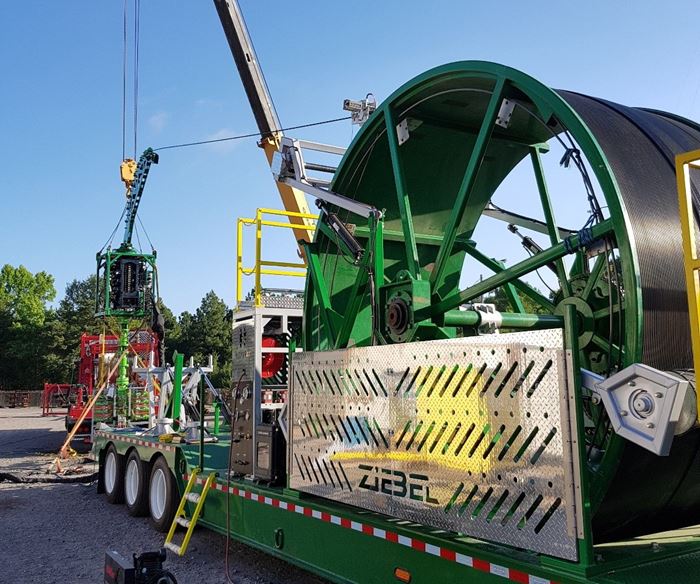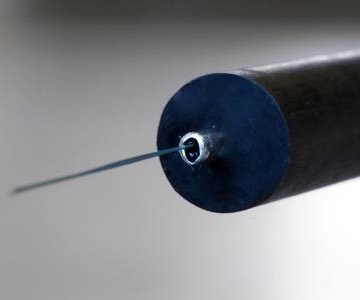Exel Composites, Ziebel cooperate on oil well sensor
Exel subsidiary Diversified Structural Composites develops pultruded carbon fiber/epoxy rod with integrated sensor for downhole oil and gas drilling.
Exel Composites (Vantaa, Finland) company Diversified Structural Composites (DSC) reported on July 30 that it has developed a fiber-optic-embedded carbon fiber composite rod for Ziebel’s (Tananger, Norway) well intervention system. DSC’s expertise in carbon fiber pultrusion enabled the precision manufacture of the 15-mm-diameter rod with fiber optic core, which functions as a sensor, gathering valuable real-time insight on well behavior unattainable using conventional methods.
In order to make informed decisions, oil drilling and completions teams need detailed information on fluid flow in and around the borehole during production or injection. Such data is usually collected using production logging tools, but this method is operationally challenging and provides limited time- and location-specific information. Ziebel’s proprietary technology, the distributed fiber optic (DFO)-based Z-System, is said to be free of many of the constraints that limit conventional well logging effectiveness, offering improved understanding of well and reservoir behavior.
At the heart of Ziebel’s Z-System is the DSC-manufactured 6.2 -km-long, 15-mm-diameter carbon fiber rod (the Z-Rod), which delivers multiple fiber optic cables securely into the hostile downhole environment. Typically, the rod is deployed into a producing or injecting well for 48 hours where the fiber optic sensors measure temperature and acoustic vibrations along its length. This enables a variety of applications – including flow allocation, fluid movement visualization, leak detection and stimulation fluid monitoring – which are extremely valuable for optimal well and reservoir management.
This composites-based sensing system offers further advantages, says DSC. The carbon fiber rod enables horizontal well access, since the lightweight, stiff composite rod can be pushed from the surface into the horizontal sections frequently employed in today’s wells, which is not possible with conventional tools run on a wireline unless an electrical well tractor is employed. In addition, the small-diameter carbon fiber rod can access wells with restricted internal diameters and difficult geometry where other tools will not pass. It also minimizes the choking effect on the well, and unlike metals, it is inert to the majority of hazardous and corrosive substances found in the downhole environment.
Ziebel contacted US-based carbon fiber pultrusion specialist DSC in 2006 to develop and manufacture the composite rod required to launch its fiber optic intervention technology in the oil sector.
To ensure the required combination of strength, stiffness and corrosion resistance necessary for this application, DSC selected one of its proprietary, tough epoxy resins and a specific carbon fiber selected through extensive testing to maximize mechanical performance. This resin places particularly challenging demands on the pultrusion process, since it requires a very slow cure in order to attain its optimal properties. This means that to produce each 6.2-km-long rod, the pultrusion line must run continuously, without fault, for more than three weeks.
"Because of the high cost of both the carbon fiber and the fiber optics, the process risk is very high," David Lewis, DSC's director of technology and business development explains. "We've therefore performed extensive work to develop a pultrusion process that is extremely robust and foolproof, and exceptional process controls are in place to ensure that there are no failures."
Ziebel and DSC have worked together to optimize a spooling technology to facilitate the handling and transport of long lengths of pultruded rod. This enables the stiff carbon fiber rod to be wound onto reels that are small enough in diameter to allow shipping from DSC’s production facilities in Erlanger, KY, US, to Europe and the Middle East, as well as within the US. An NDT process is used to monitor rod quality, since the product is continuous it cannot be cut for inspection.
"We have a great deal of trust and confidence in our partners at DSC that will enable us to continue pushing the boundaries for carbon composites in the hostile downhole environments of oil and gas wells. Our next generation of Z-Rod will take us to operating temperatures of 350°F (177°C), opening up additional wells for our services," says Neil Gardner, Ziebel's vice president of technology.
Related Content
Plant tour: Albany Engineered Composites, Rochester, N.H., U.S.
Efficient, high-quality, well-controlled composites manufacturing at volume is the mantra for this 3D weaving specialist.
Read MoreMFFD thermoplastic floor beams — OOA consolidation for next-gen TPC aerostructures
GKN Fokker and Mikrosam develop AFP for the Multifunctional Fuselage Demonstrator’s floor beams and OOA consolidation of 6-meter spars for TPC rudders, elevators and tails.
Read MoreComposite resins price change report
CW’s running summary of resin price change announcements from major material suppliers that serve the composites manufacturing industry.
Read MoreCompPair adds swift prepreg line to HealTech Standard product family
The HealTech Standard product family from CompPair has been expanded with the addition of CS02, a swift prepreg line.
Read MoreRead Next
Developing bonded composite repair for ships, offshore units
Bureau Veritas and industry partners issue guidelines and pave the way for certification via StrengthBond Offshore project.
Read MorePlant tour: Daher Shap’in TechCenter and composites production plant, Saint-Aignan-de-Grandlieu, France
Co-located R&D and production advance OOA thermosets, thermoplastics, welding, recycling and digital technologies for faster processing and certification of lighter, more sustainable composites.
Read More“Structured air” TPS safeguards composite structures
Powered by an 85% air/15% pure polyimide aerogel, Blueshift’s novel material system protects structures during transient thermal events from -200°C to beyond 2400°C for rockets, battery boxes and more.
Read More














.jpg;maxWidth=300;quality=90)













